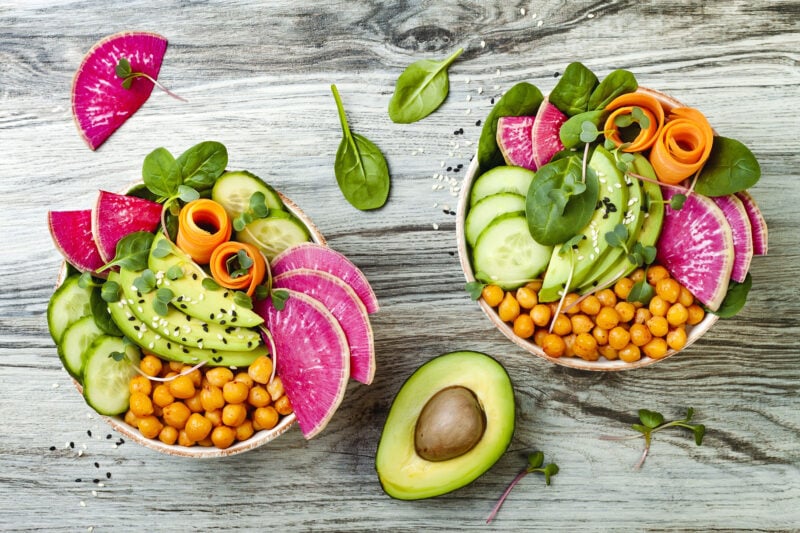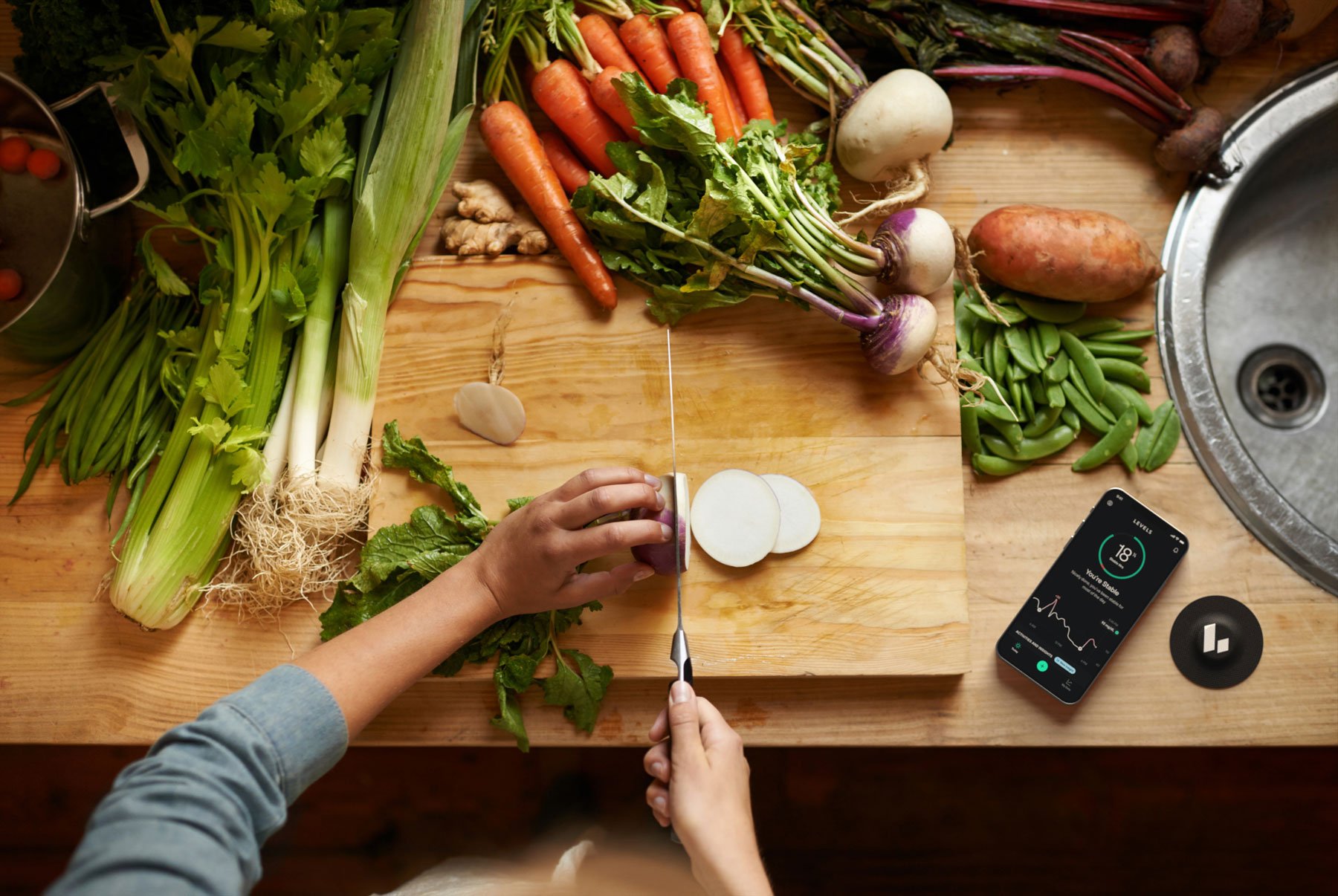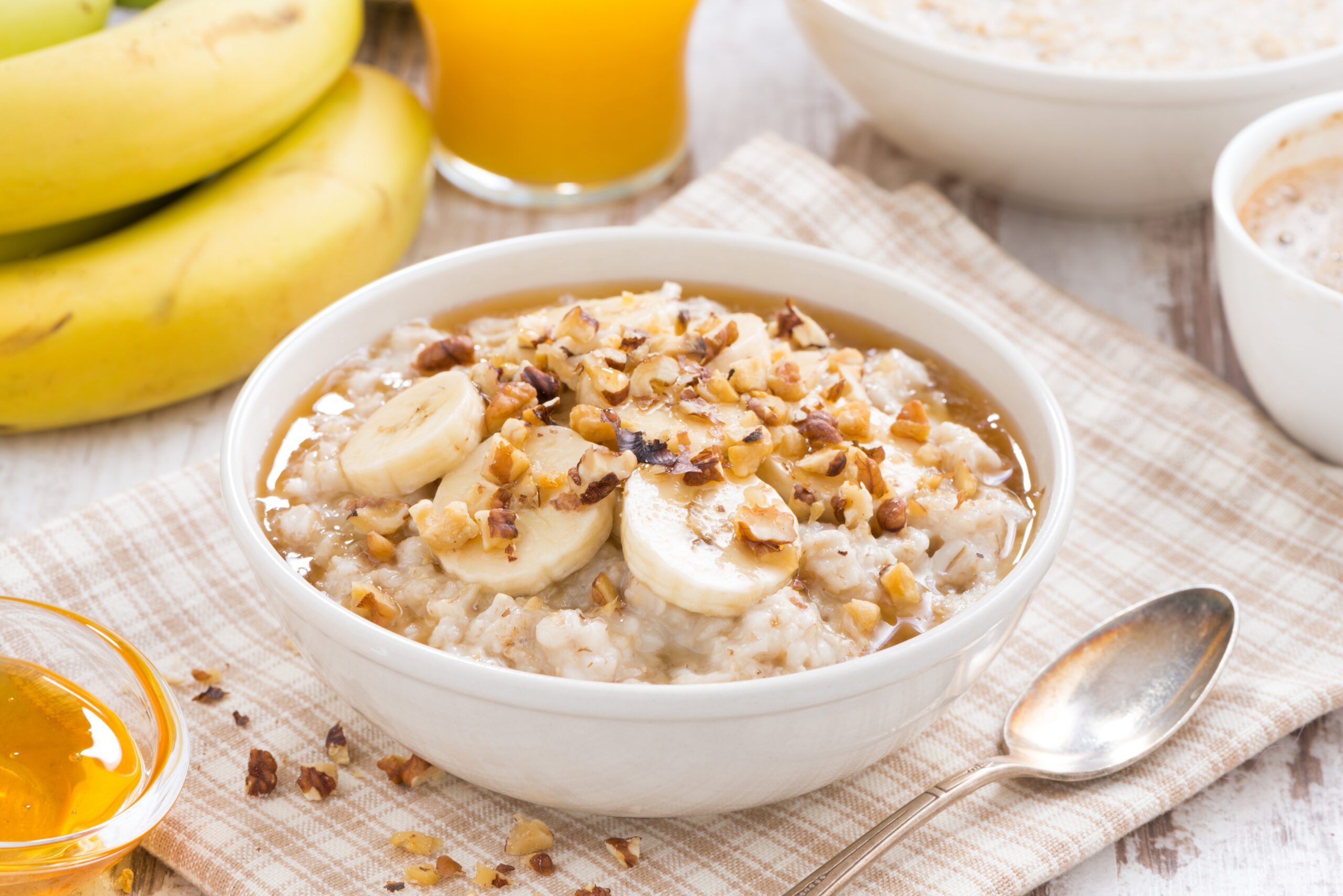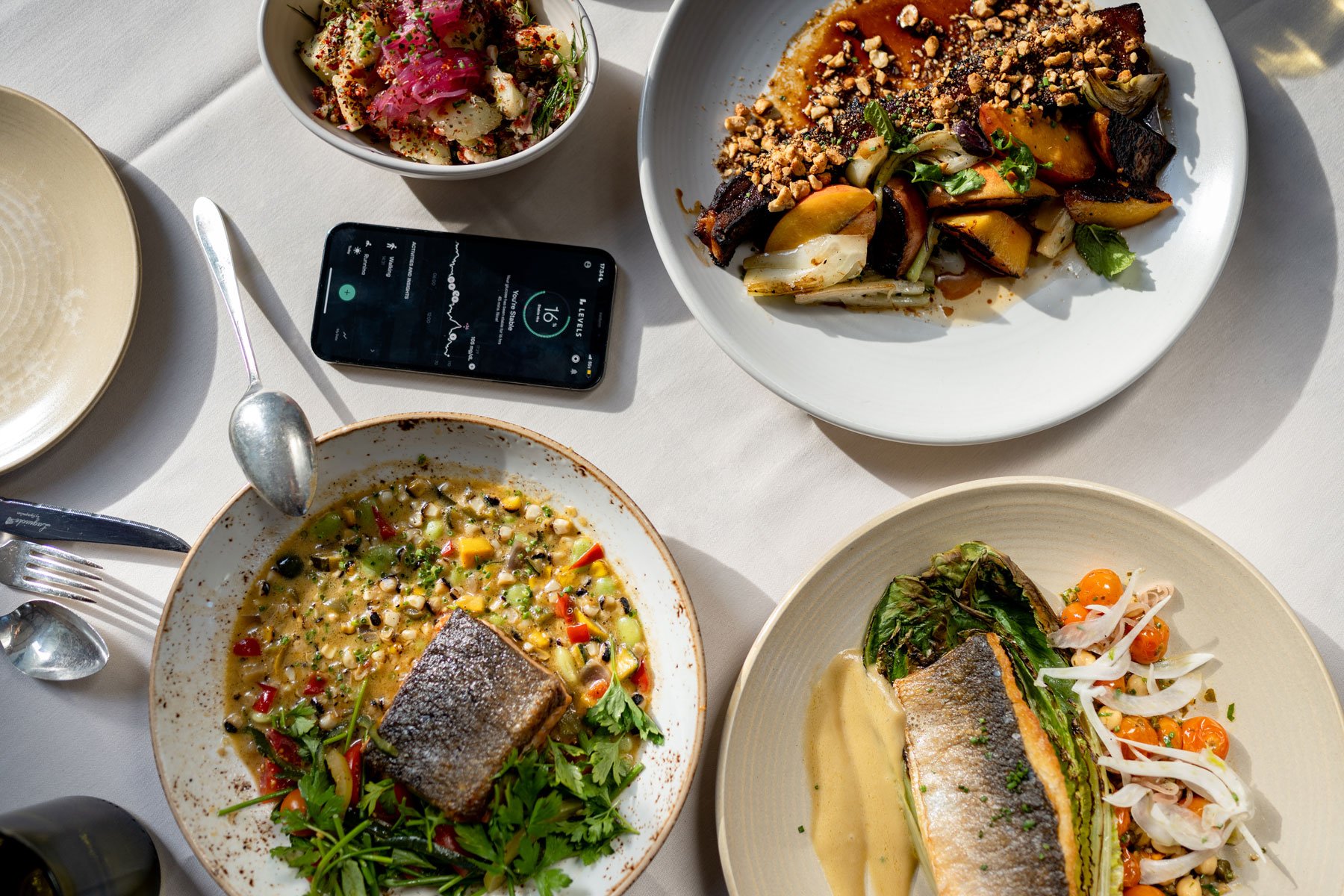Eating for metabolic health and balanced blood sugar is not the same as eating low-carb. Yes, carbohydrates become glucose when you eat them, and yes, extra glucose raises your blood sugar levels. But not all carbs are the same, and not all carbs lead to the large glucose spikes that we want to avoid for optimal metabolic health.
Foods like vegetables, fruits, and beans contain carbohydrates, and nixing them from your diet would mean missing out on some of the best sources of fiber and micronutrients. These nutrients are important for a healthy gut microbiome and powering countless physiological reactions that support optimal health and energy levels.
The carbs we want to avoid are added sugars and refined grain products—both dense sources of carbohydrates with minimal nutrients.
In addition to favoring healthy sources of carbohydrates, there are also ways you can buffer some of their potential negative metabolic effects in how you eat them and what you eat them with.
Keep reading for a practical guide to eating carbs in a way that supports metabolic health.
What are Carbohydrates?
Carbohydrates are a type of macronutrient found in certain foods and beverages. The other macronutrients are fats and proteins. Unless you’re intentionally following a very low carb diet like keto, you’ll likely eat all three as part of a healthy diet.
When someone refers to a particular food as a “carb,” it typically means it contains a higher proportion of carbs compared to fats and proteins, but it doesn’t necessarily contain only carbs (unless it’s some form of pure sugar).
Sugars, starches, and fiber are the main forms of carbohydrates in food. With the exception of fiber, carbohydrates are broken down in the body by digestive enzymes into monosaccharides, a.k.a. simple sugars. Most carbs are broken down into glucose, but, depending on the food, some yield fructose and galactose. Glucose is absorbed into the bloodstream via the intestines and serves as a primary fuel source for our cells.
You might also hear the terms “complex carbohydrates” and “simple carbohydrates.” Complex carbohydrates refer to longer, more complex carb molecules, including starches and fiber. Simple carbohydrates refer to simple carb molecules, or sugars.
Alone, these terms aren’t the most helpful for determining the healthfulness of a carb-containing food. Relative to other carbs, simple carbs are broken down and absorbed more rapidly by the body, and thus are more likely to spike blood sugar. But complex carbs in the form of starch can also elevate blood sugar. Fiber, on the other hand, slows digestion and helps buffer blood sugar spikes. All of this is why it’s important to look at both the total carbs as well as the sugar content and fiber content of a food.
What Types of Foods Contain Carbs?
Carbohydrates can be found in a wide range of foods, from highly processed fare devoid of meaningful nutrition to whole vegetables, fruits, beans, and grains that are rich in fiber and essential vitamins and minerals.
Typically, experts use a food’s level of processing to differentiate between high- and low-quality carbs. But even among whole foods, there are better and worse choices when it comes to keeping blood glucose balanced.
If you’re aiming for stable blood sugar levels, choose non-starchy vegetables such as broccoli, brussels sprouts, leafy greens, cauliflower, cucumber, mushrooms, green beans, and cabbage, and lower-sugar fresh fruits such as berries and kiwis, advises registered dietitian Zoe Atlas, MPH, RDN. You can also go for smaller portions of moderate-sugar fruits that contain a decent amount of fiber, like apples and oranges.
Whole foods that are higher in carbohydrates and more likely to impact blood sugar include starchy vegetables such as butternut squash, sweet potatoes, beets, corn, and parsnips; beans and lentils; high-sugar fruits such as bananas, mangoes, and grapes; and whole grains such as quinoa, millet, teff, buckwheat, farro, oats, and rice. These can all be a part of a nutritious diet, Atlas says, but you may need to be more mindful of your portion size, what you pair them with and how they impact your blood sugar.
On the other hand, “the more processed and refined the carbohydrate, the more pronounced the blood sugar spike,” says registered dietitian Stephanie Greunke, MS, RD. Lower-quality carbs that are best avoided include candy, soda, juice, sweeteners (table sugar, honey, maple syrup, etc), and foods made from grain-based flours (crackers, cookies, breads, pastas, cereal). All of these can be considered “acellular carbs,” says holistic nutritionist and wellness expert Kelly LeVeque, meaning they contain carbs that have been broken out of their natural fiber cell, which speeds digestion and makes them more likely to spike blood sugar.
To recap, it might help to look at it this way:
- “Always” carbs = non-starchy veggies and low-sugar fruits like berries
- “Maybe” carbs = starchy veggies and legumes, higher-sugar fruits, whole grains
- “Avoid” carbs = sodas, juices, sweeteners, flour-based products, and other highly-processed foods
Learn more:
12 Tips for Eating Carbs to Optimize Nutrition and Keep Blood Sugar Steady
Carb-containing foods can be a wonderful addition to a healthy diet, but the exact amount of carbs you should eat is not one-size-fits-all—age, sex, physical activity, body composition goals, and other factors can all play a role. That’s why giving a specific recommendation for daily carbohydrate intake can be tricky. In general, though, “it’s fair to say that 40% or less of daily calories from carbs is beneficial for most, and I often lean towards a much tighter range of 30% or less,” says Gruenke. This tighter range works out to consuming less than 150 grams of carbohydrates on a 2,000 calorie per day diet; and if you’re following an ultra-low-carb diet like keto, cap your intake at around 25 to 50 grams of carbs per day.
But if you don’t feel like counting carbs, that’s fine too. A potentially better, more flexible way to support metabolic health is to engage in eating habits known to minimize blood sugar spikes—which can be done with varying amounts of carbohydrates per individual, says Greunke. Use these tips as a guide and listen to your body.
1. Cut out added sugars, refined grains, and liquid carbs
When it comes to severe blood sugar spikes, these are the top three offenders—so start here if you need help prioritizing where to scale back.
- Added sugars—even from natural sources like honey and maple syrup—are a poor source of micronutrients and can rapidly elevate blood sugar.
- Breads, pastas, crackers, desserts, and cereals made with refined grain-based flours. These have had their fibrous components removed (or ground up, in the case of whole-grain flours), which promotes the rapid breakdown of carbs absorption of glucose into the bloodstream.
- Liquid carbs, including juice, sodas, and sports drinks, are an obvious place to cut back, but be smart about alcohol, too. A 12-ounce beer has around 12 grams of carbs, a 5-ounce glass of wine contains 4 grams, and hard liquor, while relatively low in carbs, is often combined with sugary sodas and juice. Plus, research suggests that no amount of alcohol is good for you (contrary to popular belief that moderate drinking is healthy). Try low-carb alternatives like a seltzer mocktail or bitters and soda.
2. Opt for whole or minimally processed carb foods
Unlike heavily processed fare, whole foods retain their fiber and micronutrients—so even if they deliver some carbs, they’re at least packaged with beneficial compounds that help buffer blood sugar spikes and support metabolic health. “I would focus on filling up [most of] your plate with non-starchy vegetables, which will add bulk and fiber for satiety, as well as vitamins, minerals, and antioxidants,” says Atlas. Nutritious options include:
- Leafy greens (spinach, kale, arugula, bok choy, swiss chard)
- Broccoli
- Brussels sprouts
- Cauliflower
- Cabbage
- Bell peppers
- Carrots
- Asparagus
- Green beans
- Mushrooms
- Avocado
- Celery
- Eggplant
- Cucumber
- Artichoke
- Tomato
- And more
Other carb-containing whole foods that make a healthy addition to many peoples’ diets include low-sugar, high-fiber fruits (e.g. kiwi, raspberries, blackberries, blueberries, and strawberries), and moderate-sugar, high-fiber fruits such as apples and oranges. Legumes are also a great choice—they’re higher in protein and fiber than other starchy plant foods and typically don’t spike blood sugar when paired with a fat (another pro tip: navy beans, lima beans, and lentils are lower in carbs than other legumes). While still nutritious, starchy veggies, whole grains, and high-sugar fruits should generally make up a smaller portion of your diet.
Not all packaged foods are bad news, either. Minimally processed freezer and pantry staples like canned beans, frozen veggies without sauces, and unsweetened frozen fruits are a great way to keep high-quality carb-containing foods on hand.
3. Consider your unique response to carbs
While the recommendations above generally hold true, everyone has a somewhat unique response to the same carb-containing foods—so, for example, you could experience large swings in blood sugar even with whole foods like beans, apples, or oats, while your friend does not. Using a continuous glucose monitor (CGM) is the easiest way to evaluate your response to specific foods and modify their intake accordingly, but you can also check blood sugar after meals with an over-the-counter fingerstick test.
4. Don’t eat carbs alone
As a general rule, when carbohydrates are the primary macronutrient in a food or meal, pair them with protein and fat to slow digestion and minimize post-meal blood sugar elevations. These two macros signal the release of hormones in the gut that slow gastric emptying, thereby reducing the rate at which glucose enters the bloodstream.
This also works with desserts. Try pairing a piece of dark chocolate with some nut butter, or make baked goods with collagen or protein powder, Greunke suggests. Or, if a treat is better on its own, eat it right after a meal containing protein, fiber, and fat as opposed to waiting.
5. Prioritize protein early in the day
“A protein-rich breakfast not only helps at the immediate meal, but it can also support healthier glucose levels throughout the rest of the day, including at the next meal,” Greunke says. Consider options like a three-egg scramble (or tofu scramble) with bell pepper and onions, Greek yogurt with berries and walnuts, or chia pudding made with protein powder to set the tone for a day of balanced blood sugar, steady energy, and fewer cravings.
Be sure to get sufficient protein over the course of the day, too, as suboptimal intake may lead to cravings for sugar, according to LeVeque. Her recommendation: Shoot for around 0.75 grams of protein per pound of body weight per day—that’s about 113 grams for a 150-pound person.
6. Minimize carbs at night
Your body is generally more insulin sensitive (i.e. your cells are more efficient at taking up glucose from the bloodstream) in the morning. So consuming a carb-rich food earlier in the day—say, a banana after lunch rather than dinner—will lead to a milder blood glucose response.
At dinner, aim for mostly or all low-carb foods, such as a protein-rich salad or meat with a side of non-starchy veggies. And try to stop eating a few hours before bed.
7. Pregame with apple cider vinegar or fiber
If you want pizza and no low-carb alternative will do, drink an eight-ounce glass of water mixed with 1 tablespoon of apple cider vinegar (ACV) before eating to buffer the metabolic impact, Greunke suggests. The acetic acid present in ACV is thought to curb post-meal elevations in blood sugar in three ways:
- It suppresses the activity of enzymes responsible for breaking down carbs into simpler sugars that can then be absorbed into the blood
- It makes cells more efficient at taking up glucose from the bloodstream (i.e. enhancing insulin sensitivity)
- It slows the rate at which food leaves the stomach and enters the intestines, where glucose is absorbed
Not into ACV? Try a chia fresca beverage: Mix one to two spoonfuls of chia seeds with 16 ounces of flat or sparkling water and optional flavor boosters like a squeeze of fresh citrus. Chia seeds are a potent source of fiber and healthy fats—and contain a bit of protein, too—all of which help set the stage for balanced blood sugar.
8. Take a quick walk after a carb-rich meal
Post-meal movement is great to support healthy digestion, and it’s especially beneficial after eating higher-carb foods. One recent study found that taking periodic two- to five-minute walking breaks after a meal significantly lowered post-meal blood sugar levels compared to standing or sitting. The likely reason: Your muscles use glucose for fuel, so when you fire them up during exercise, you increase their uptake of glucose from the bloodstream, lowering blood glucose levels.
9. Seek out satisfying low-carb alternatives
Some low-carb foods make surprisingly delicious stand-ins for carb-rich favorites like noodles, breads, and more—and they completely upgrade the nutrient profile of your meal.
- Use frozen cauliflower instead of a banana to bulk up a smoothie, or turn a head of cauliflower into cauliflower rice or cauliflower mash that’s surprisingly close to mashed potatoes.
- Try almond flour tortillas, homemade flax wraps, coconut wraps, leafy greens like collards and romaine lettuce, nori sheets, or bell pepper halves as an alternative to traditional tortillas, wraps, and sandwich bread.
- Zucchini noodles, beet noodles, carrot noodles, spaghetti squash, kelp noodles, and long, thin enoki mushrooms make low-carb, nutrient-rich noodle alternatives. Even certain packaged noodles like this edamame spaghetti pack significantly more protein and fiber than traditional spaghetti noodles, which will buffer their impact on blood sugar.
- For something sweet, try these lower-carb, higher-fiber ice cream alternatives, these blood sugar-friendly desserts, or a small portion of high-cocoa (70 to 80 percent or higher) dark chocolate from brands like Alter Eco and Hu.
- Upgrade your condiments with low-sugar, low-carb options from brands like Primal Kitchen, or make one of these delicious DIY dressings containing no added sugar.
10. Consider net carbs, but don’t fall for marketing claims
The term net carbs refers to the number of carbs broken down and digested by the body that impact on blood sugar. To calculate net carbs, you subtract the grams of fiber, erythritol, and allulose, and half the grams of other sugar alcohols (e.g. xylitol) from the total carb content. For whole or minimally processed foods without these added sweeteners, you’d simply subtract the fiber from the total carb content.
Total carbs – fiber – allulose – erythritol –½(other sugar alcohols) = net carbs
“Calculating net carbs allows individuals more flexibility to consume nutrient-rich foods like fruits, vegetables, and legumes and still fall within their preferred carbohydrate range,” Greunke explains.
However, packaged foods with low net carb counts are best consumed in moderation. Processed foods with sugar alcohols and added fiber may cause GI distress in some people, and they often contain additives and preservatives.
11. Calculate the carb-to-fiber ratio
When choosing high-fiber foods: Consider the carb-to-fiber ratio. As mentioned, fiber falls under the carbohydrate category, but it can actually help manage blood sugar levels (as opposed to elevating them), since it largely passes through the GI tract intact and without being broken down into glucose. “What you’re looking for is a total carbohydrate-to-fiber ratio of less than 5:1,” according to metabolic health expert Dr. Robert Lustig. So if a food has 10 grams of total carbs, it should have at least 2 grams of fiber (unless it’s a food that doesn’t naturally contain fiber, like cheese or plain yogurt).
12. You don’t have to be strict low-carb or keto
While it can be tempting (and sometimes quite helpful) to slash carbs in the name of balanced blood sugar and metabolic health, certain people may have a higher demand. Performance athletes, very lean people, kids, nursing and pregnant women, and some women in their reproductive years may need more carbs to feel their best.
One reason: “Very low carb diets can alter levels of important hormones such as leptin (which regulates satiety) and T3 (active thyroid hormone, which plays a key role in metabolism),” Atlas says. “Because leptin is secreted primarily by white fat cells and responds to changes in blood sugar, an individual with low body fat might benefit from a higher-carb diet so that they don’t experience excessive hunger levels. Leptin can also impact the reproductive cycle via the hypothalamic-pituitary-gonadal (HPG) axis, so very lean, active women should be careful not to restrict carbohydrates too much, as it may cause menstrual irregularities.”
If you fall into one of these groups, you don’t need to eat high-carb, Greunke adds—you may just need to scale up a bit until you find that sweet spot that supports both your physical demands and metabolic health. You may also be a prime candidate for carb-cycling, an approach where you generally eat low-carb or even keto, but periodically intersperse higher-carb days that correspond with increased activity or certain phases of your menstrual cycle to support hormone balance and/or workout performance.
“Higher-carb days when you need more glucose can work in your favor by providing sufficient energy for your workouts, accelerating recovery, supporting hormonal health, and allowing your body to efficiently use both carbs and fat for energy—known as metabolic flexibility,” says Greunke. But keep pairing your carbs with protein and healthy fats to curb spikes, advises Atlas.
Want to learn more about how carbs impact your metabolic health?
Levels, the health tech company behind this blog, helps people improve their metabolic health by showing how food and lifestyle impact your blood sugar, using continuous glucose monitoring (CGM), along with an app that offers personalized guidance and helps you build healthy habits. Click here to learn more about Levels.









